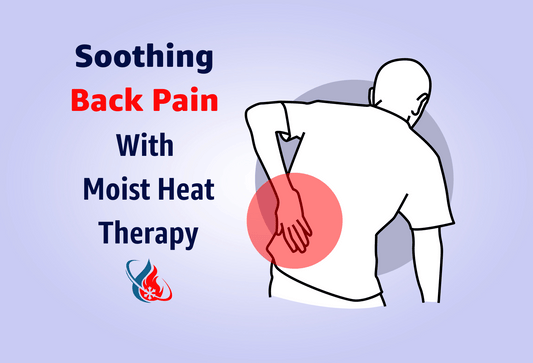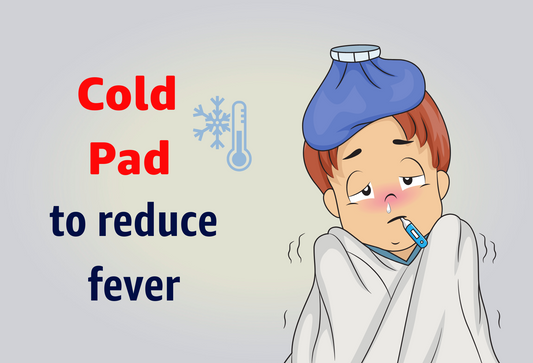How A Cold Pad Can Help Reduce Fever?
Fevers can be scary. Especially if you are a parent and your child is sick or if you are caring for a loved one. Thankfully, there are ways that a fever can be reduced naturally, in most cases.

But what is a fever, and how can a cold compress bring a temperature down?
What is a fever?
According to the Mayo Clinic, a fever (also known as pyrexia) is a response from the immune system causing a temporary rise in body temperature. It's the way our body lets us know it is fighting some illness or infection. Each person’s baseline body temperature varies, but generally, the average normal body temperature is approximately 98.6 degrees Fahrenheit (37° C). Therefore, measuring a fever between adults, children, and infants will vary.
- Infants – The average infant's body temperature ranges from 97 to 100 degrees Fahrenheit. It may be reassuring to determine your baby's baseline body temperature with your pediatrician. Most physicians consider a fever in an infant at 100.4° F or higher.

- Children – A fever is diagnosed when the body temperature rises to about 100°. After infancy, there are several ways to check a child’s body temperature if a fever is suspected:
- Rectal – Fevers greater than 100.4° F (38° C)
- Ear – Fevers greater than 100.4° F (38° C
- Forehead - Fevers greater than 100.4° F (38° C)
- Oral – Fevers greater than 100°F (37.8° C)
- Under the arm – Fevers greater than 99° F (37.2° C)
- Adults – An adult’s body temperature will vary due to physiology, physical activity, and time of day. The average adult body temperature is 98.6 degrees Fahrenheit. Older adults generally have a lower body temperature than younger adults. Most doctors consider adults to have a fever when a temperature reaches above 100.4°

There are a lot of myths when it comes to fevers. The truth is that fevers are a good sign that the immune system is activated, alerting us to a problem and naturally addressing it.
How to reduce a fever using cold compresses?
If you are trying to reduce a fever at home, there are many ways to use simple cold therapy methods to find relief.
- Cooling Pad – Cooling pads are a quick and easy way to use cold therapy to reduce a fever. Versatile pads like THESE reusable pads are designed and handmade in Canada by Anna Robinson. She developed a company called Harti that offers products that can be used for both cold and heat therapy methods. The pads can be sealed in a freezer bag, put in the freezer, cooled to the desired temperature, and then applied to the affected area.

Harti provides cooling pads that can assist in other areas of the body by decreasing inflammation and swelling due to migraines, injuries, or other ailments. All fabrics are 100% plant-based cotton in double layers to create a safe barrier protecting the skin. In addition, all products are naturally sourced and filled with 100% locally grown oats.
You can use a cold pack on a few areas of your body:
on the wrists, under the arms or on the groin or forehead area.
Placing a cool pad on these areas is an effective way to bring down your body temperature because this is where the blood vessels are close to the surface of the skin. The cold pack will help cool the blood as it travels through these areas and after that, throughout the rest of the body, effectively lowering the body temperature.

Placing a cold pack on your forehead can bring instant relief when you have a fever, reducing headaches and burning sensation, and aid in lowering your body temperature.
During a fever, the body may feel warm to the touch but cold inside. Caution should be taken when using cooling strategies. Look for symptoms of shivering, as this can cause the fever to rise and become dangerous.
Other ways to reduce body temperature during a fever
Alternative options for decreasing body temperature include:
- Cold Wash Cloth – If you don’t have a cooling pad, you can use a cold washcloth to help lower a fever. Find a washcloth, towel, or rag and turn on the cold-water faucet. Saturate the fabric with cold running water. Wring out the cloth removing the excess water to avoid dripping. Apply the cold washcloth to the forehead or back of the neck.
- Lukewarm water – Showering, sitting in a bathtub, giving a sponge bath, or drinking lukewarm (or room temperature) water can help soothe a fever. However, soaking in water that is too cold can generate the opposite

- Wear light clothing
- Use a fan to circulate and cool the airflow
- Avoid using heavy blankets
- Vicks vapor rub – though there is no medical evidence that vapor rub reduces fever, the natural eucalyptus, camphor, and menthol have a cooling effect when applied to the neck, chest, and bottoms of the feet.
- Over-the-counter medication – Some over-the-counter medicines like naproxen, acetaminophen, ibuprofen, or aspirin can lower body temperature, relieve headaches, and reduce discomfort.
Cold pads are easy to use and can effectively reduce body temperature upon the onset of the fever. However, be sure to contact your medical provider if your fever continues to increase, even when trying at-home remedies, especially if you have any concerns.







